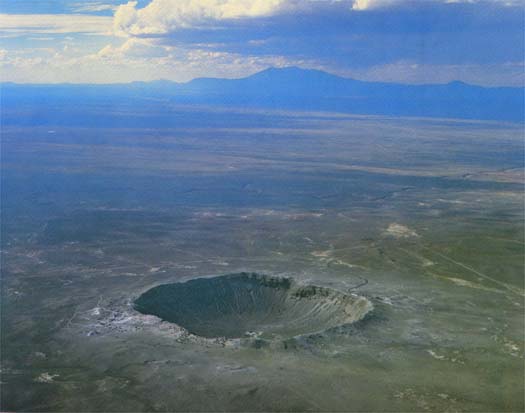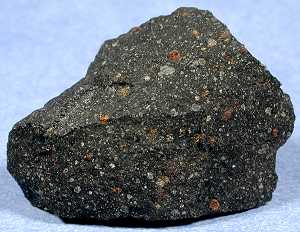METEORITE SAMPLES
The meteorites that collided and accreted to form Earth consist mostly of carbonaceous chondrites, stony meteorites, similar in composition to Earth's crust and mantle, containing minerals, water, and carbonaceous molecules, such as amino acids. These molecules, when subjected to the toxic, hot conditions of early Earth and given enough energy, can combine to produce the building blocks of life. How we got from the building blocks to the next step still remains a mystery and is the subject of active research.

Meteor Crater, Arizona, Photo by D.J. Roddy and K.Zeller, USGS

Murchison Meteorite picture from http://www.meteorlab.com/METEORLAB2001dev/murchy.htm
The Murchison Meteorite is:
"A carbonaceous chondrite which exploded into fragments over the town of Murchison, 400 km north of Perth, Australia, on September 28, 1969. About 82 kg of the meteorite was recovered. Eyewitnesses arriving at the scene reported smelling something like methanol or pyridine, an early indication that the object might contain organic material. Subsequent analysis by NASA scientists and a group led by Cyril Ponnamperuma revealed the presence of 6 amino acids commonly found in protein and 12 that did not occur in terrestrial life. All of these amino acids appeared in both dextrorotatory (right-handed) and laevorotatory (left-handed) forms, suggesting that they were not the result of Earthly contamination. The meteorite also contained hydrocarbons which appeared abiogenic in character and was enriched with a heavy isotope of carbon, confirming the extraterrestrial origin of its organics. Initial studies suggested that the amino acids in the Murchison meteorite showed no bias between left- and right-handed forms. However, in 1997, John R. Cronin and Sandra Pizzarello of Arizona State University reported finding excesses of left-handed versions of four amino acids ranging from 7 to 9%,1 a result confirmed independently by another group. More than 70 amino acids have been identified in Murchison altogether. To this organic mixture, in 2001, was added a range of polyols - organic substances closely related to sugars such as glucose."
Above text from http://www.daviddarling.info/encyclopedia/M/Murchison.html, copyright David Darling.